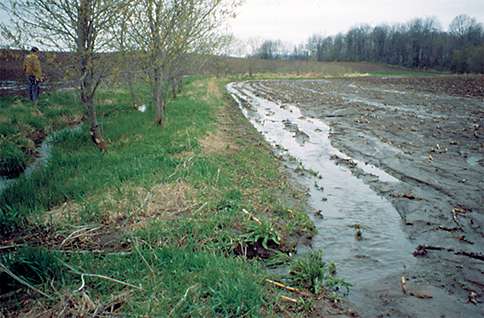Scientists found that important aspects of water’s movement over the surface and through the subsurface have consequences for modeling how carbon is released and stored by the environment. Water runoff can affect soil moisture and soil temperature, ultimately affecting the amount of carbon “locked” into plants. Image courtesy of the U.S. Geological Survey, Wisconsin Water Science Center. Credit: U.S. Geological Survey, Wisconsin Science Center
The starting point often changes the finish. A team led by researchers at Pacific Northwest National Laboratory modeled runoff, that is, water's movement over the land surface and through the subsurface, using two widely adopted methods. They found that the modeling choices result in differences that ultimately swing results in carbon cycle simulations—by as much as 20%. The differences in modeling runoff methods cause substantial differences in the soil moisture that also changes soil temperature.
Moisture is an important element in making sure that the planet provides adequate food and that water is plentiful. It is also a vital ingredient for the climate system's water, energy, and carbon cycles. This study highlights the significant interactions among these cycles. Discovering their connections will help better represent key water-based parameters in land surface models to better simulate real-world behaviors.
A team of scientists, led by Pacific Northwest National Laboratory, is seeking to learn how soil moisture influences climate. The investigators studied how uncertainties associated with using two very different representations of soil hydrology affect modeling of plant productivity and the carbon cycle. Using the Community Land Model (CLM) version 4 with two widely adopted runoff-generation parameters, the team found that the global water balance is sensitive to runoff. The two parameters cause a relative difference of about 35% in global mean total runoff and soil moisture, as well as substantial differences in their spatial distribution and seasonal variability. Consequently, the simulated global mean gross primary production differs by 20% because differences in soil moisture simulated between the two models directly influence leaf photosynthesis through soil moisture availability. Soil moisture content also indirectly alters vegetation traits through moisture impacts on soil temperature.
More information: Huimin Lei et al. Sensitivity of global terrestrial gross primary production to hydrologic states simulated by the Community Land Model using two runoff parameterizations, Journal of Advances in Modeling Earth Systems (2014). DOI: 10.1002/2013MS000252
Provided by US Department of Energy
























